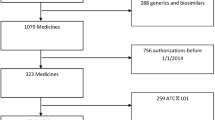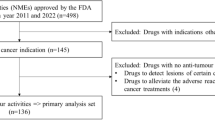Abstract
In the last two decades, simultaneous global development of novel drugs become more common by conducting multiregional clinical trials. However, regulatory authorities of different regions often make different decisions on the approvals of the same new drugs. We would like to discuss the appropriateness of Japanese regulatory approach through a case study of quizartinib, a novel anti-leukemia drug developed in Japan. The pivotal clinical trial “QuANTUM-R” conducted in 19 countries showed a modest increase in median overall survival with quizartinib than the conventional chemotherapy. However, because several critical defects in this trial were pointed out by the United States Food and Drug Administration (US FDA) and the European Medicines Agency (EMA), quizartinib has not been approved in the US and Europe to date. On the contrary, the regulatory authority of Japan gave a notice of approval to quizartinib as a “standard of care”, and the country becomes the sole country that granted market authorization. In our paper, we provide more detailed discussion about the methodology for scientific evaluation of the new drug.
Similar content being viewed by others
Availability of data and material
Not applicable. This manuscript does not include any experimental data or material.
References
Watanabe A, Chang SC, Kim MJ, Chu DWS, Ohashi Y (2010) Long-acting neuraminidase inhibitor laninamivir octanoate versus oseltamivir for treatment of influenza: A double-blind, randomized, noninferiority clinical trial. Clin Infect Dis 51(10):1167–1175. https://doi.org/10.1086/656802
Cyranoski D (2019) The potent effects of Japan’s stem-cell policies. Nature 573:482–485. https://doi.org/10.1038/d41586-019-02847-3
Tanimoto T, Tsubokura M, Mori J, Pietrek M, Ono S, Kami M (2013) Differences in drug approval processes of 3 regulatory agencies: A case study of gemtuzumab ozogamicin. Invest New Drugs 31(2):473–478. https://doi.org/10.1007/s10637-012-9877-8
Larrosa-Garcia M, Baer MR (2017) FLT3 Inhibitors in acute myeloid leukemia: Current status & future directions. Mol Cancer Ther 16(6):991–1001. https://doi.org/10.1158/1535-7163.MCT-16-0876
Cortes JE, Khaled S, Martinelli G et al (2019) Quizartinib versus salvage chemotherapy in relapsed or refractory FLT3-ITD acute myeloid leukaemia (QuANTUM-R): a multicentre, randomised, controlled, open-label, phase 3 trial. Lancet Oncol 20(7):984–997. https://doi.org/10.1016/S1470-2045(19)30150-0
US Food & Drug Administration, Advisory committee meeting (2019) https://www.fda.gov/advisory-committees/advisory-committee-calendar/may-14-2019-meeting-oncologic-drugs-advisory-committee-meeting-announcement-05142019-05142019. Accessed 16 Feb 2021
ASH Clinical News (2019) Mixed opinions on quizartinib from the FDA and Japanese regulators. https://www.ashclinicalnews.org/news/latest-and-greatest/mixed-opinions-quizartinib-fda-japanese-regulators/. Accessed 16 Feb 2021
Targeted Oncology (2019). Complete response letter issued by FDA for quizartinib NDA in AML. https://www.targetedonc.com/view/complete-response-letter-issued-by-fda-for-quizartinib-nda-in-aml. Accessed 16 Feb 2021
Report of Deliberation (2019) Pharmaceutical Evaluation and Control Division, Pharmaceutical and Life Sciences Bureau (article in Japanese). https://www.pmda.go.jp/drugs/2019/P20190628001/430574000_30100AMX00017_A100_1.pdf. Accessed 16 Feb 2021
Cheson BD, Bennett JM, Kopecky KJ et al (2003) Revised Recommendations of the International Working Group for diagnosis, standardization of response criteria, treatment outcomes, and reporting standards for therapeutic trials in acute myeloid leukemia. J Clin Oncol 21(24):4642–4649. https://doi.org/10.1200/JCO.2003.04.036
Author information
Authors and Affiliations
Contributions
Keisuke Kidoguchi wrote the manuscript. Motoharu Shibusawa confer critical revision of the manuscript. Tetsuya Tanimoto contributed to provide administrative and technical support for the draft writing.
Corresponding author
Ethics declarations
Consent for publication
Not applicable. Formal consent is not required.
Research involving Human Participants
All procedures involving human participants were performed in accordance with the ethical standards of the institutional and/or national research committee, and in accordance with the 1964 Helsinki Declaration and its later amendments (or comparable ethical standards).
Disclosure of potential conflicts of interest
Tetsuya Tanimoto reports personal fees from Medical Network Systems Inc., and Bionics co., ltd, outside the submitted work. All the other authors declare no conflicts of interest.
Additional information
Publisher's Note
Springer Nature remains neutral with regard to jurisdictional claims in published maps and institutional affiliations.
Rights and permissions
About this article
Cite this article
Kidoguch, K., Shibusawa, M. & Tanimoto, T. A critical appraisal of Japan's new drug approval process: a case study of FLT3-ITD inhibitor quizartinib. Invest New Drugs 39, 1457–1459 (2021). https://doi.org/10.1007/s10637-021-01151-0
Received:
Accepted:
Published:
Issue Date:
DOI: https://doi.org/10.1007/s10637-021-01151-0




